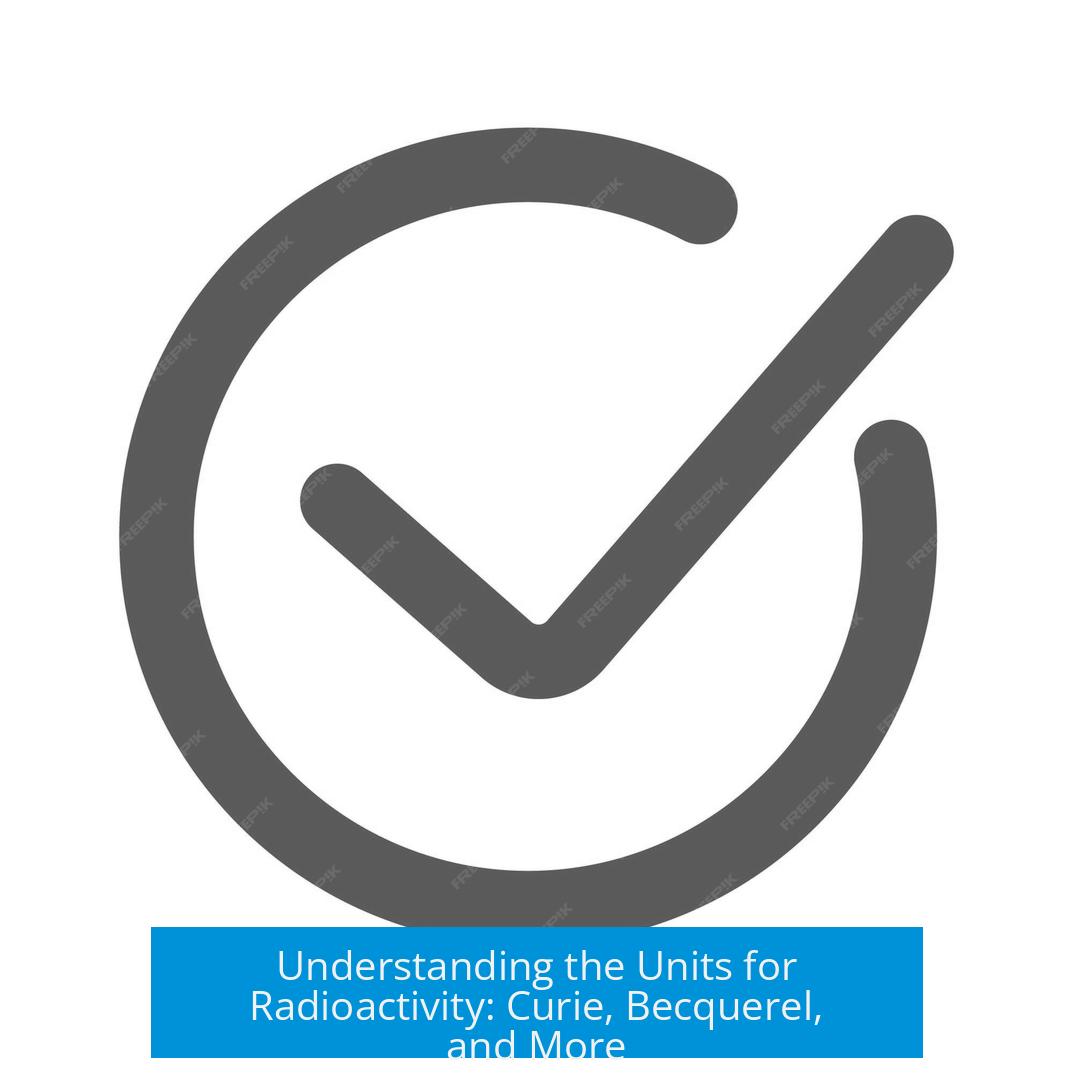Understanding the Unit for Radioactivity

The primary unit for radioactivity is the Becquerel (Bq), defined as one nuclear decay per second. This unit quantifies the actual number of radioactive disintegrations occurring in a sample per second. It directly answers the question: how active is this radioactive material at this moment?
The Becquerel is part of the International System of Units (SI), designed for universal and precise measurement. Its adoption standardizes how scientists and technologists quantify radioactivity worldwide.
Curie vs. Becquerel: Different Scales of Radioactivity
The Curie (Ci) is a traditional unit of radioactivity. It is defined based on the activity of a radium sample and equals 3.7 × 1010 Becquerels. This means 1 Curie corresponds to 37 billion nuclear decays every second.
While curies are not SI units, they still see use, especially in North America and in some industries due to historical precedent.
| Unit | Definition | Relation |
|---|---|---|
| Becquerel (Bq) | One nuclear decay per second | SI unit of radioactivity |
| Curie (Ci) | Activity of 1 gram of radium | 1 Ci = 3.7 × 1010 Bq |
Different Units for Related Radiation Quantities
The term “radioactivity” often requires clarification because units measure different aspects of radiation.
Absorbed Dose Measurement: Gray and Rad
When radiation energy is absorbed by matter, the quantity of interest is the absorbed dose. Its SI unit is the Gray (Gy), defined as one joule of radiation energy absorbed per kilogram of material. The Gray primarily measures physical damage potential due to radiation.
The Rad is a legacy unit where 1 Rad equals 0.01 Gy. Though largely replaced by the Gray, it’s still seen in some older literature and US practical contexts.
Equivalent Dose: Sievert and Rem
The absorbed dose alone does not describe biological impact. Different radiation types affect tissue differently. To account for this, the equivalent dose is used.
The SI unit is the Sievert (Sv), which weights the absorbed dose by radiation type and biological damage factors. For example, alpha particles cause more damage per unit energy than gamma rays, so they have a higher weighting factor.
The older equivalent unit is the Rem (Roentgen Equivalent Man), where 1 Sv equals 100 Rem. The Rem is still used in some sectors such as the US Navy.
Exposure: Roentgen and Coulomb per Kilogram
Exposure measures ionization in air from photons. The legacy unit is the Roentgen (R), relating to how much charge ionizes a kilogram of air.
The SI unit is the Coulomb per kilogram (C/kg), directly quantifying ionization charge created. Usage of these units has declined with a shift toward absorbed and equivalent dose units.
Summary Table of Radioactivity and Radiation Units
| Quantity Measured | SI Unit | Legacy Unit(s) | Definition |
|---|---|---|---|
| Radioactivity (Decay Rate) | Becquerel (Bq) | Curie (Ci) | Number of decays per second |
| Absorbed Dose | Gray (Gy) | Rad | Joules of energy absorbed per kilogram |
| Equivalent Dose (Biological Effect) | Sievert (Sv) | Rem | Absorbed dose weighted by radiation type’s biological impact |
| Exposure (Ionization of Air) | Coulomb/kg (C/kg) | Roentgen (R) | Charge ionized in air per kilogram |
Interpreting Radioactivity Units in Practice
Choosing the correct unit depends on context:
- Measuring the intensity of a radioactive source: Use Becquerel or Curie. This tells how many atoms decay per second inside the material itself.
- Assessing how much energy radiation deposits in tissue or materials: Use Gray or Rad. This measures actual energy absorption, which may damage matter.
- Estimating health impact of radiation exposure: Use Sievert or Rem. These account for different radiation types and biological effects.
- Measuring radiation exposure in air (older practice): Use Roentgen or Coulombs per kilogram.
These units serve different purposes and should not be confused. Radioactivity (decay rate) is distinct from dose or exposure, which relate more to radiation effects than the amount of activity alone.
Common Analogies for Understanding Units
To visualize these differences, analogies are sometimes used:
- Curie/Becquerel: Like the “fizziness” level in a soda; it shows how many particles “pop off” per second.
- Roentgen (Exposure): How much “fizz” is escaping into the air near the soda.
- Rem/Sievert (Equivalent Dose): How much fizz enters your body and what biological effect it has.
Key Takeaways
- The unit for radioactivity usually means the number of nuclear decays per second, measured in Becquerels (Bq).
- Curie (Ci) is a non-SI legacy unit, equal to 3.7×1010 Bq.
- Gray (Gy) and Rad measure energy absorbed by matter, focused on physical damage.
- Sievert (Sv) and Rem measure biological effect, weighting the absorbed dose.
- Roentgen and Coulomb/kg measure ionization of air, mostly obsolete units.
- Each unit addresses different phenomena; knowing context is essential for proper use.
What is the basic unit used to measure radioactivity?
The becquerel (Bq) is the basic unit for radioactivity. It measures one nuclear decay per second, showing how active a radioactive sample is.
How does the curie (Ci) relate to the becquerel?
The curie is another unit for radioactivity based on radium’s activity. One curie equals 3.7 × 1010 becquerels, making it a much larger unit than the becquerel.
What is the difference between becquerel and sievert?
Becquerel measures the decay rate of radioactive material. Sievert measures the biological effects of radiation absorbed by tissue, weighting the energy by its potential harm.
Why are there multiple units for radioactivity?
Different units measure different aspects: decay rate, energy absorbed, or biological effect. The choice depends on whether you track activity, dose absorbed, or damage risk.
Are units like rem and rad still commonly used?
Rem and rad are older units replaced largely by sievert and gray. Some industries, like the US Navy, still use rem, but sieverts and grays are now standard worldwide.
What does the roentgen (R) measure in radioactivity?
Roentgen measures ionization of air caused by radiation. It is mostly a legacy unit now, replaced by coulombs per kilogram, though it occasionally appears in older literature.





Leave a Comment